On a metaphorical level, death is an interruption. Rosie Larsen is a bright young girl. She plans to go to college, evidently a point of contention in the Larsen household. But her encounter with a murderous stranger interrupted her plans. Death, despite being the one certainty in life, is almost never planned, and murder even less so.
Death is also the reason for the events of The Killing to transpire. And in this context, death also functions as an interruption.
What do Jerry Orbach and Ben Bratt do between murder cases on Law & Order? Apparently nothing. They don’t exist until a dead body summons them, at which point they appear like Furies and descend upon the unrighteous. But Detective Sarah Linden has a life outside of casework. It’s a life she’s leaving, in fact. She’s packing up, ready to quit her job in Seattle PD and move to Southern California with her fiancee. And then her boss asks her to check on a bloody sweater found in a field. Death has interrupted Linden’s routine.
Death interrupts Stan Larsen as well, who gets a phone call notifying him that his daughter’s missing. His normal routine would probably consist of making deliveries or pickups similar to the one we saw. Death interrupts his wife Mich’s routine, too; she has to ask a family friend to pick the kids up from school. Death pulls Rosie’s closest friend, Sterling, out of class to be interrogated by her principal.
In case the meaning isn’t clear enough, the pilot episode distracts us with literal interruptions as well. Watch Linden when she gets the clue that leads to Rosie’s body. She’s standing in a field, the same field where Rosie’s sweater was found. The police have swept this field and the surrounding woods all afternoon. Her intuition tells her something’s there, but her logical faculties haven’t put all the pieces together yet.
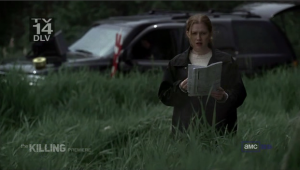
Her partner wants to go, so he keeps leaning on the car horn.
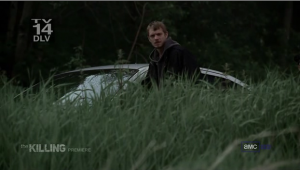
Her cell phone rings. It’s her fiancee, who’s flown ahead to California without her. She’s still going to be on that plane tonight, right?
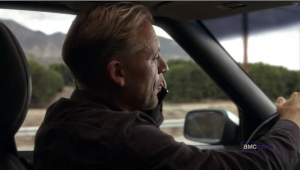
She’s got a map in her right hand.
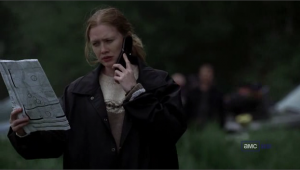
Oh, and there’s a barking dog.
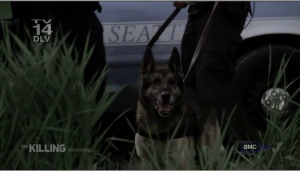
Mrurr?
Linden has four different stimuli competing for her attention. And it’s clear, looking at her face, that none of them really matter to her right now. Her real focus is on the puzzle: if Rosie Larsen was here, where did she go?
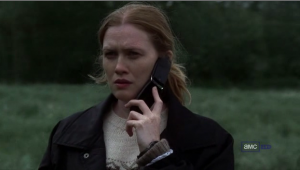
Look, just gimme a minute.
If Linden could do her job without all these distractions, there’s a good chance she could get out of here on time. She wouldn’t have to miss her flight. But she can’t. She keeps getting interrupted. She has a blizzard of different things blowing in to distract her. A lesser person might choose to focus on any one of those: yelling at her partner, placating her fiancee, asking someone to shut up that dog. But Larsen doesn’t. She concentrates and sees something we don’t.
Why don’t we see it? Because we’re distracted. The camera keeps jumping from one stimulus to another. Our POV keeps getting interrupted.
And this is what it’s like to have your world overturned by a violent crime. It’s not a perfect simulation, obviously: the confusion of a senseless loss has little to do with the confusion of smash cuts and a jarring soundtrack. But it’s an approximation by degrees. It shows that Sud (and the other producers of The Killing) are trying. It’s important to them to convey the loss of balance, the disorientation and the interruption that a tragic death can impose on someone’s life.
Why? Because this isn’t just any death. This isn’t just the murder-of-the-week to keep the series going. You need to pay attention.
Time to drop the impartial critic act: The Killing impressed me more than any pilot I’ve ever seen. I think Mad Men is the best thing going on television right now, and even Mad Men struggled in its first episodes. But straight out the gate, The Killing has shown more craft and intelligence than most movies I’ve seen. It’s TV that eats like a movie. I say that because The Killing uses the language of film – techniques of cinematography, sound and pacing – to impart a sophisticated theme. That theme: forget what you know. Discard your preconceptions. Pay attention to everything.
And that’s just the pilot. If you haven’t seen the rest of the series to date, you’re missing out.
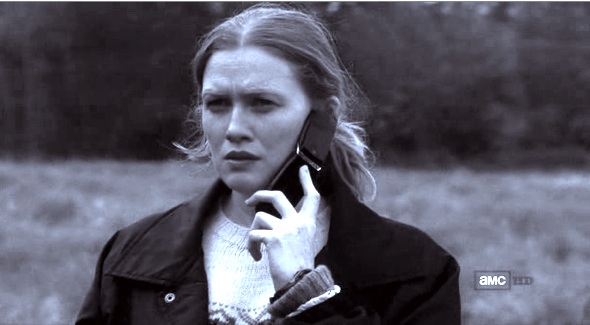
Regarding the Steadicam bit: I’d be willing to put a dollar on the guy being on a Segway, like this Eurovision bit: http://www.youtube.com/watch?v=3f3mUs7rS1I
Day-amn! That’s some fancy footwork!
The Steadicam has always fascinated me. A Steadicam + Segway just blows my mind.
Not just that, though; pity the poor focus guy who had to keep up on foot!
The fakeout crime scene/going away party scene felt off to me as regards the rest of the script’s intelligent twisting of tropes. It came off as too much of ‘he was just one week away from retirement’ for me. That said, I agree that this is a very strong pilot and series thus far (4 episodes in). I give the pilot 9 out of 10 as a result.
I have a very high regard for the pilot episode of Veronica Mars. It succeeds in establishing the many principal characters (and there is no character drift throughout season one) and the overall story arc that ran the entire season. Veronica was a high school girl the likes of which hadn’t been shown on TV (at least not American TV). She was worldly and still young girl-ish.
Regarding character drift I mentioned above, pilot episodes are fascinating to compare to regular season episodes. While a flawed pilot can still produce a good series, a well executed pilot is almost certain to do so. Go back and watch the pilot of The West Wing and I think you’ll agree the only character nailed by the actor was Toby Zeigler (Richard Schiff). Everyone else to varying degrees didn’t understand their character yet (which could well be that Sorkin didn’t yet know them).
The Killing is very good TV, and has already become a show to which I look forward. As to the look, it reminds me of how well Wallander is shot. Both are atypical for series television.
Patrick
I didn’t have time to add Wallander to my list of shows to watch when it first came out, but The Killing has definitely made me want to check it out again. However, the time dilemma is still pretty much the same. :-P
I don’t know if you watched the TV series “Murder One”, but the first season is pretty good – one season, one case, from the litigation perspective. It really did get to delve further into everyone’s lives.
Plus – it’s got Stanley Tucci in it, playing a pretty good sleazeball.
Also, Patricia Clarkson chopped A LOT of vegetables!
Patrick
Great critique – makes a lot of sense! But are you perhaps giving Sud a little too much credit? I haven’t seen the American version, but I have seen the Danish original and it sounds from your description like it’s pretty much a carbon copy of that. Maybe Sud should be praised for not changing it, but I don’t think they are her original ideas …
@Perich: Good critique/review! I’m going to present your observations as my own.
@Zoe: The Killing/Sud is just following a trend in the business. There are a lot of examples of non-english scripts being run thru google translate and then being slapped with the name of a new writer. Examples that immediatly come to mind are Let me in and The next three days.
It’s propably not done in malevolance. It’s maybe a manifestation of somekind of cultural protectionism.
Anyways, the credit hoarding for translating and script doctoring is not helping in building the appreciation that the craft of writing deserves. Methinks…
Great break down, I love the series too. Minor quibble (and the sort of meaningless minutia that is only worth mentioning on a site called Overthinkingit) but Sonoma is in Northern, not Southern California. That stuff matters a great deal to us San Francisccans